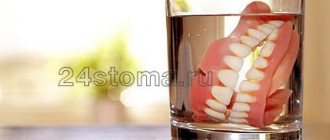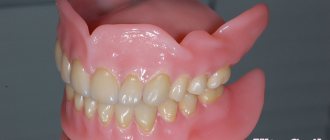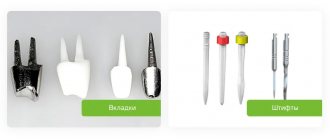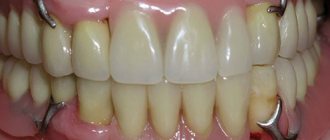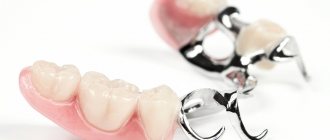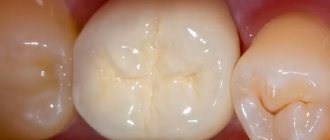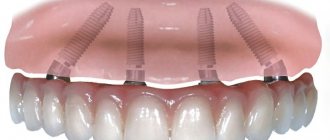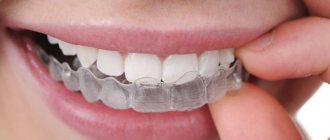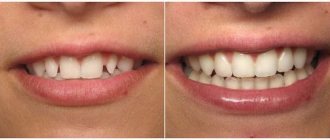Chief editor of the site:
Snitkovsky Arkady Alexandrovich
Chief physician of the professorial dentistry “22 Century”, dentist, orthopedic dentist
Author of the article:
Scientific team of dentistry “22 Century”
Dentists, candidates and doctors of medical sciences, professors
Adhesive prosthetics allows you to restore a lost tooth with minimal grinding of neighboring ones. This gentle technique does not require preparation on all sides (as with traditional bridges) and is successfully used in the 22nd Century dental clinic. It is especially suitable for those who believe that their own enamel is always better than artificial material.
Why does the bridge have this name?
What it is becomes clear if you clarify the meaning of the word “adhesion”. Adhesion (from the Latin adhaesio) is the ability of dissimilar materials to stick to each other. Thus, a bridge of this type is not attached to ground support units using crowns, but is “glued” to the teeth adjacent to the defect. It is called Maryland, or even Manhattan, because of the shape of the structure - an artificial tooth-base and “wing” plates extending from it on both sides.
%akc61%
Its difference from a conventional bridge is that it is fixed by means of these thin plates, which are located on the side of the tongue and are attached to the inside of two supporting elements. This attachment is almost invisible in the oral cavity.
Read more about classic dental bridges in the material “Review of bridge models: for what cases are they suitable, how much do they cost and how long will they last?”
Care instructions
In order for the product to last a long time, compliance with the rules and recommendations for care is mandatory. These include:
- mandatory brushing of teeth at least twice a day;
- regularly rinse your mouth after breakfast, lunch and dinner using mouth rinses;
- using dental floss to better clean the area where the prosthesis is installed;
- Visit your doctor once or twice a year for professional dental cleanings.
In addition to care measures, it is important to avoid too hard foods; you should also not open bottles with your teeth or crack nuts - all this will end in breakage of the product.
Indications for use of the Maryland bridge
A bridge structure of this type is often used only to restore one tooth in the frontal area, less often – two in a row. This is explained by the fragility of the structure, since it is not intended for heavy chewing loads1. The Maryland bridge in dentistry is used in the following cases:
- restoration of one or two missing teeth in a row without grinding adjacent ones,
- temporary prosthetics of 1–2 units for the period of implant healing or if it is impossible to immediately begin permanent bridge prosthetics,
- the need for simultaneous defect replacement and splinting due to periodontal diseases.
Read about the methods that are suitable for replacing lost front teeth in the material “What dentures can be placed in the smile area - the most complete list of solutions and their features.”
Positive sides
As soon as this method began to be practiced in dentistry, a large number of patients actively began to become interested and give preference to this method of dental restoration. The popularity is due to the following factors:
- Affordable price.
- Very fast result.
- Preservation of healthy teeth unchanged.
- This denture looks very neat in the mouth.
- At the right time, it can be easily removed in the dentist’s office.
- You can restore two teeth at once.
- No complex equipment required.
Types of bridge structures and materials used
There are quite a few types of fastenings and materials for adhesive bridge prosthetics. The most commonly used materials for these restorations are base metals, composites, fiberglass2, ceramics and plastics. There are several types of adhesive bridges:
- fiberglass or elongated metal plate - a beam, the middle of which is a crown of composite material, and the edges are strips glued to the supports. At the same time, the plates also have small holes into which dental glue penetrates for better adhesion to the enamel,
- a fiberglass pin and two plates that are connected with a special tape. An aesthetic dental crown is fixed on top, which can be made from various lightweight materials,
- a fiberglass or ceramic bridge with inlays, to secure which the cavities of neighboring teeth formed after caries treatment are used. The “wings” of the bridge are glued not to the inside of the teeth, but from above; they are placed in the cavity of the supports and correspond to their anatomical shape. Such a prosthesis is similar to restorative dental inlays combined with each other with a crown in the center, replacing the missing element.
In each situation, the doctor individually selects the design that will be most reliable for the patient. This largely depends on the condition of the adjacent teeth and the location of the unit.
Steps to install an adhesive bridge
The installation of a Maryland bridge can be carried out in one or several visits to a specialist. This is largely influenced by the condition of the supporting teeth on which the prosthesis will be fixed, as well as the features of the chosen design. The stages of manufacturing the structure will depend on the chosen technique: it is possible to manufacture the prosthesis both in the laboratory and clinically, that is, directly in the patient’s mouth.
The following main stages of adhesive-bridge prosthetics can be distinguished:
- treatment of supporting teeth: if necessary, cleaning, caries treatment, grinding or surface treatment of enamel is carried out. Minimal sanding is necessary to ensure adhesion of surfaces,
- taking impressions: used when the bridge is made in the laboratory, and not directly in the mouth during the appointment,
- production of the prosthesis: with the indirect method, it is carried out in the laboratory, especially when made from materials such as plastic and ceramics, the processing of which is impossible in the oral cavity. With the direct method, that is, directly in the oral cavity, the prosthesis is made by a doctor in one visit. The optimal material for the direct method is a light-curing composite,
- fixation of dentures: the structure is fixed using special dental cement.
Reviews
Patients note that installation is inexpensive and the prosthesis is quickly manufactured. Getting used to it occurs after just a few days of wearing it. Share your feedback on the use of an adhesive bridge or the choice of prostheses in the comments to this article.
If you find an error, please select a piece of text and press Ctrl+Enter.
Tags adhesive bridge fixed dentures fixed dentures
Did you like the article? stay tuned
Previous article
Curettage of periodontal pockets: types, features and reviews
Next article
Possible complications after tooth extraction surgery
The advantages of this type of prosthetics
Among the advantages, the following qualities of such structures have been identified:
- the adjacent supporting units, as well as the gums, are not injured when fixing the prosthesis. And this is perhaps the main advantage of adhesive prosthetics, which attracts many patients,
- fast recovery,
- there is no need for anesthesia when preparing for prosthetics,
- low cost of treatment,
- the ability to replace the prosthesis without damaging the supporting teeth,
- are non-removable, which distinguishes them favorably from immediate prostheses (“butterflies”), used as temporary structures,
- high aesthetics: when using ceramics or composite materials, crowns look natural, and the shade of the prosthesis can be precisely selected.
You can evaluate the advantages of various types of fixed prosthetics in the article on our website “Comparison of fixed prostheses.”
Manufacturing technique
At the first appointment, the doctor will examine the patient’s oral cavity and take into account clinical indications.
The client then needs to wait for the prosthesis to be made in the laboratory. Before this, it is proposed to choose the color, shape of the prosthesis and indicate the degree of its transparency.
The following technologies are used to manufacture an adhesive prosthesis:
- Clinical method . Indicates that the artificial product is formed directly in the patient’s oral cavity.
- Laboratory method . When the patient first visits the clinic, the doctor will take appropriate impressions. It will take time to make a prosthesis, but such a restoration is considered more effective. They are used when ceramics or plastic are used as the material.
- Combined method . It is used at the discretion of the dentist and involves the combination of two technologies (direct and laboratory).
A number of significant disadvantages of adhesive bridges
Despite the large list of advantages, the Maryland Bridge also has disadvantages. The disadvantages are as follows:
- relative fragility of the prosthesis: it is for this reason that dentures are not installed in the chewing zone and do not replace more than two units with them. This design is not designed for high loads, it can come off, so it is recommended to handle the prosthesis as carefully as possible, try not to bite or chew food at the site where the prosthesis is installed,
- fragility of the structure: it is used for temporary prosthetics, since the service life of even the most durable structures is no more than 3–4 years,
- incomplete restoration of a missing tooth: the prosthesis serves rather to eliminate a cosmetic defect, but does not restore functionality, that is, it cannot be fully chewed,
- complication of hygiene in the places where the prosthesis is attached and in the interdental spaces, which increases the risk of developing caries.
Despite the restoration of the row under the adhesive prosthesis, bone atrophy continues to progress at the site of the lost tooth. The lack of chewing load reduces tissue nutrition and accelerates bone loss, which over time leads to various negative consequences.
Life time
The relatively low strength of composite materials determines the comparative fragility of the adhesive prosthesis. On average, it will last about five years, with careful handling - a maximum of 10-12. The service life directly depends on how strictly the patient adheres to the recommendations of the attending physician. To prolong the life of the adhesive bridge, you should avoid hard foods and do not put stress on your teeth. It is necessary to systematically brush your teeth using floss and various rinses. The main task is to prevent the occurrence of secondary caries, which can lead to loss of supporting teeth.
Alternatives to adhesive bridge prosthetics
Adhesive bridge prosthetics today are used by those patients who want to restore one unit without installing implants and damaging adjacent teeth. But its features and the impossibility of using it for different groups of teeth force many patients to look for an alternative.
A gentle type of restoration of one element without turning adjacent ones is also cable-stayed prosthetics. However, cable-stayed prosthetics still require, albeit minor, trauma to the supporting elements. However, too heavy loads are not recommended, as the prosthesis may collapse.
Classic bridge prosthetics, compared to adhesive ones, has a much longer service life and can withstand full chewing loads. But installing a bridge requires grinding and depulping the adjacent supporting teeth. In addition, a permanent bridge can be quite expensive, especially when made from zirconium dioxide or precious metal alloys.
%akc72%
If the teeth have already been pulpless before, then installing a bridge on them makes sense. However, if they are healthy, the best option for restoring what is missing would be to install a crown on an implant. The cost of such prosthetics varies depending on the type of implantation and the selected materials. However, this is justified by the maximum service life and complete functional restoration of the tooth.
Cost of adhesive bridge prosthetics
The price for manufacturing a Maryland bridge depends on the chosen technology and construction materials. Compared to other types of fixed prosthetics, the price is low and varies from 8 to 10 thousand rubles per unit and higher.
- Karapetyan T.A. Rationale for choosing a Maryland bridge / Bulletin of Medical Internet Conferences. – 2022.
- Grishin S.Yu., Zholudev S.E. Restoration of single included defects in the dentition with adhesive bridges with glass fiber reinforcement. – 2006.
Prices
The cost of a structure is influenced by many factors. First of all, it all depends on the choice of dental clinic. The qualifications of the doctor and the level of the center increase or decrease the price of an artificial prosthesis . The difference is about 15-20%.
The material from which the bridge is made also matters:
- Plastic is the cheapest, costing about 1,000 rubles;
- Alloy of chromium and cobalt 3,000 – 4,000 rubles;
- metal ceramics will cost 5,000 – 6,000 rubles.
Since the structure can be installed on several supports, the price also increases with their addition. If a single piece of ceramics costs 15,000 rubles, then a system for three units costs 44,000 rubles.
